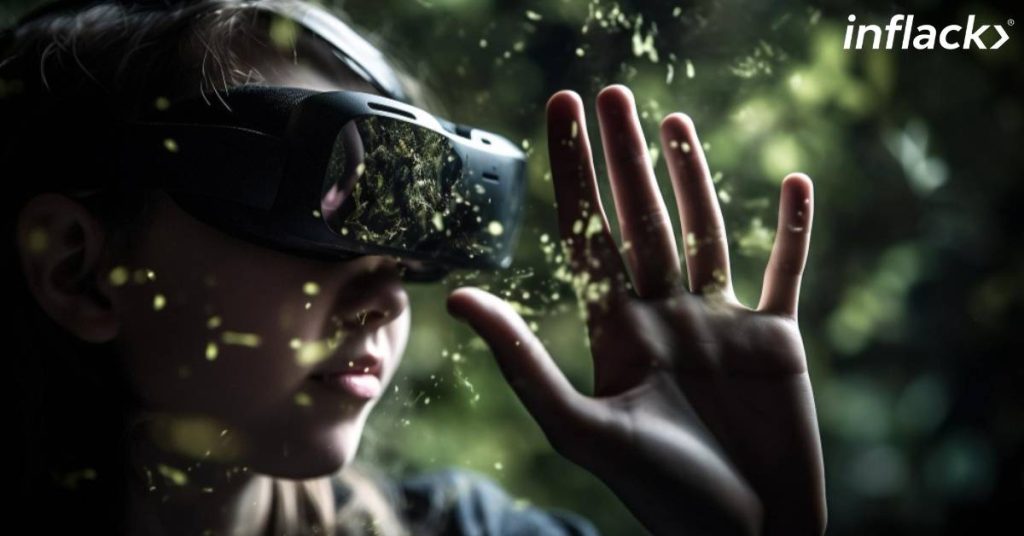- Demystifying Cloud Computing: A Deep Dive into its Impact and Future in the Software Industry - January 17, 2024
- Navigating the Future: The Latest Trends Shaping the Tech Industry in 2024 - January 16, 2024
- The Imperative of User Experience in Android Mobile App Development - December 18, 2023
The fusion of our physical and digital worlds is underway, reshaping the canvas on which businesses operate. Augmented Reality (AR), a pioneering technology, is at the forefront of this transformation. It overlays digital data onto the real world, offering a hybrid experience that captivates the senses. While movies like “Iron Man” and “Minority Report” gave us a fictional glimpse into AR’s potential, today’s businesses are making it a reality, pushing boundaries to redefine consumer experiences and optimize operations. This article dives deep into the dynamic realm of AR, exploring 10 innovative applications across diverse industries.
1. Retail Experiences
Retail has always been about touch, feel, and experience. Yet, the rise of e-commerce platforms threatened the essence of brick-and-mortar stores. AR emerged as the bridge, merging the tangible with the digital.
Virtual Storefronts
Take the example of IKEA. Their AR application, IKEA Place, is nothing short of revolutionary. Through the app, customers can virtually place furniture in their own homes, seeing how different products fit and look in real contexts. This ability to ‘try before you buy’ not only enhances user confidence but also decreases the likelihood of product returns. Similarly, brands like Gucci have integrated AR in their mobile apps, letting users try sneakers virtually before making a purchase.
Virtual Try-Ons

The beauty industry has seen a significant uptick in AR adoption. Sephora’s Virtual Artist App is a prime example. Customers can try on different shades of lipsticks, eyeshadows, and more – all virtually. The app uses facial recognition to overlay makeup products onto the user’s live video feed, making shade selection more accurate and personal. The result? An enriched customer experience and informed buying decisions.
2. AR Manuals for Products
The thick, printed manuals that come with products can be intimidating to many. They’re often tossed aside, leading users to either guess their way around the product or search online for guidance. AR brings an interactive solution to this age-old problem.
Interactive User Guides
Dyson, known for its innovative range of household appliances, took product manuals to the next level with AR. By scanning a QR code on their product, users are led to an interactive guide. Here, they can see 3D animations showing assembly instructions, maintenance protocols, and even troubleshooting steps. This interactive and visual method not only simplifies the user journey but also enhances product accessibility for all age groups.
On-the-Go Troubleshooting
LEGO, the renowned toy company, has an AR-powered app that helps users in assembling their sets. If a user gets stuck at a step, the app can overlay assembly instructions on the actual pieces, guiding them in real-time. This minimizes frustration, making the building process seamless and enjoyable.
3. Enhanced Training Modules
Traditional training methods often require hefty resources, dedicated spaces, and can sometimes pose risks, especially in fields like medicine or aviation. AR presents a safer, more immersive alternative.
Medical Training
Consider the medical field, where precision is paramount. AR can facilitate intricate surgeries by superimposing a digital image onto a surgeon’s field of view. For instance, AccuVein, a handheld scanner, uses AR to visualize veins, making venipuncture (inserting a needle into a vein) more accurate. Similarly, medical students can now practice surgical procedures in a risk-free virtual environment before working on actual patients.
Aviation and Military Training
Flight simulators have been around for years, but with AR, the experience is further elevated. Trainee pilots can wear AR glasses or headsets, providing them with real-time data overlays while they’re in an actual aircraft. This blend of real flight experience combined with digital guidance can accelerate training timelines. Similarly, in military training, AR can simulate battlefield scenarios, offering soldiers a realistic training ground while ensuring safety.
4. Real-time Navigation and Tourism

Ever been lost in an airport or a massive shopping mall? Or wandered around a foreign city wishing for a personal tour guide? AR has the potential to redefine our exploration experiences.
Indoor Navigation
Gatwick Airport introduced an AR navigation system in 2017. By integrating around 2,000 beacons within two terminals, visitors could use their smartphones to find specific gates, restrooms, or cafes. These AR directions, appearing on live camera feeds, provided travelers with easy-to-follow pathways, eliminating the stress of missing flights.
Cultural Exploration
Imagine touring Rome’s Colosseum and seeing gladiators battling in real-time through your AR-enabled device. Apps like “Augmentour” offer such experiences. Tourists can point their devices at historical landmarks to view reconstructed scenes from the past, offering context, history, and an immersive experience that a traditional tour might lack.
5. Interactive Gaming Experiences

Gaming isn’t just about sitting in front of a console anymore. AR brings the gaming environment to life, overlaying digital elements in the real world, leading to truly immersive experiences.
Pokémon GO
One can’t discuss AR gaming without mentioning Pokémon GO. Launched in 2016, this game took the world by storm. Players wander in real-life environments, using their smartphones to capture virtual Pokémon that appear as if they’re in the same location as the player.
Harry Potter: Wizards Unite
Building on the concept of Pokémon GO, this game immerses players in J.K. Rowling’s magical universe. With AR, players can cast spells, discover mysterious artifacts, and encounter iconic characters and beasts in the real world.
6. Virtual Property Tours
The real estate industry has evolved dramatically with the inclusion of AR, allowing potential buyers and renters to tour properties from the comfort of their own homes.
Virtual Open Houses
Companies like Zillow offer 3D home tours, allowing users to virtually walk through a property. With AR, this experience becomes even more immersive. Users can place their own furniture, change wall colors, or visualize renovations, ensuring the property aligns with their preferences before even setting foot inside.
Construction & Architecture
AR can be a powerful tool for architects and builders. Apps like ARki offer a blend of 3D architectural models superimposed onto the environment, helping stakeholders better visualize the end product and potentially spotting design flaws before actual construction begins.
7. Enhanced Classroom Learning
Education, particularly in the K-12 sector, is always seeking innovative methods to engage students more deeply and make learning more interactive.
Interactive Learning
AR takes textbooks and lessons to a whole new level. Consider an AR-enabled textbook that, when viewed through an AR application, animates a historical battle or shows a 3D model of the human heart, allowing students to interact and engage with the material in real-time. Platforms like AR Flashcards make learning more dynamic, especially for younger students.
Field Trips without Leaving the Classroom
Imagine taking students on a tour of Ancient Egypt or the depths of the ocean without leaving their seats. With apps like Google Expeditions, teachers can guide students through 360° scenes and 3D objects, pointing out interesting sites and artifacts along the way.
8. Personalized Advertisement and Marketing
In today’s world, customers are looking for personalized experiences. AR offers businesses a unique way to tailor marketing materials to each individual.
Virtual Dressing Rooms
Stores like Uniqlo have introduced ‘Magic Mirrors’, allowing customers to virtually try on outfits. The mirror changes the color of the clothing the person is wearing, helping them decide without physically trying on multiple items.
Interactive Billboards and Posters
Pepsi created an unforgettable AR experience at a bus stop in London. The brand transformed a regular bus shelter’s glass into a fake ‘live’ feed of the street behind it, but with surprising additions — from alien invasions to prowling tigers. Passersby were amazed, and the campaign went viral, showcasing AR’s potential for memorable marketing stunts.
9. In-Store Shopping Experience Enhancement
The retail industry has begun integrating Augmented Reality to bridge the gap between online and in-store shopping experiences.
Interactive Product Descriptions
Consider walking into an electronics store. With AR, customers can point their phone at a product to instantly receive reviews, video demonstrations, or specs. It’s like having a personal shopping assistant at one’s fingertips.
Virtual Trial for Accessories and Makeup
Stores like Sephora use AR through their mobile app, allowing users to virtually “try on” makeup products. Similarly, retailers selling glasses or jewelry are using AR to let customers see how products look on them, all without physically trying them on.
10. Automotive Industry Integration
The automobile sector has started harnessing the power of AR for both manufacturing and user experience purposes.
Virtual User Manuals
Instead of thumbing through a hefty car manual, imagine pointing your phone at your car’s engine and getting step-by-step AR instructions on changing the oil or identifying a component. Hyundai’s AR manual does exactly this.
Enhanced Navigation Systems
Rather than the traditional GPS, AR can superimpose directions onto the road in real-time using heads-up displays (HUDs). Companies like WayRay offer such navigation solutions, enhancing driving safety and convenience.
The Future of Augmented Reality
The momentum behind AR is undeniable, and its potential for future applications is vast.
- Integration with AI: Pairing AR with Artificial Intelligence can give rise to more intuitive applications. For instance, using facial recognition, AR glasses could display a person’s name and recent interactions you had with them, which can be immensely helpful in a business networking context.
- Advanced Wearables: While AR on phones is impressive, the next logical step is wearable tech. Think AR glasses or even contact lenses. Companies like Apple and Facebook are reportedly investing heavily in this area.
- Holodecks and Fully Immersive Environments: Drawing inspiration from science fiction, researchers are exploring the potential of AR ‘holodecks’—rooms that use AR to create fully immersive experiences. Whether for training, gaming, or collaborative work, this could revolutionize how we interact with digital content.
Conclusion: Augmented Reality – Bridging the Gap Between Imagination and Reality
Augmented Reality, once a staple of science fiction, has woven its way into the fabric of our everyday lives. From enhancing classroom education to redefining in-store shopping experiences, AR is proving its mettle across myriad industries. As we’ve explored, whether it’s the virtual dressing rooms of the retail world or the advanced navigation systems in automobiles, AR is not only adding value but also elevating the user experience to new dimensions.
Yet, what stands out most is the vast untapped potential of AR. The horizon is brimming with possibilities. With rapid advancements in technology and increased integration with AI, wearables, and other digital interfaces, the line between our physical reality and augmented experiences is set to blur further.
For businesses and innovators, this presents a golden opportunity. Staying ahead of the curve, understanding emerging AR trends, and leveraging them could be the difference between fading into obsolescence and riding the wave of digital transformation.
As we stand on the cusp of a new era shaped by Augmented Reality, one thing is certain: the future looks not just promising, but truly ‘augmented’. The question isn’t whether we’ll adapt to this technology, but how swiftly can we integrate it to enrich, simplify, and enhance our lives further. Welcome to the age of AR; a world where reality is limited only by our imagination.




